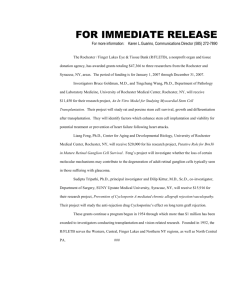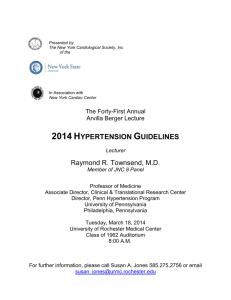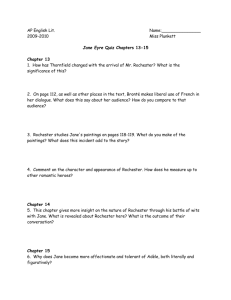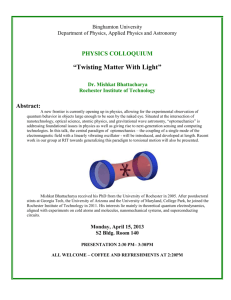Geography quiz 2011 - Monroe Community College
advertisement
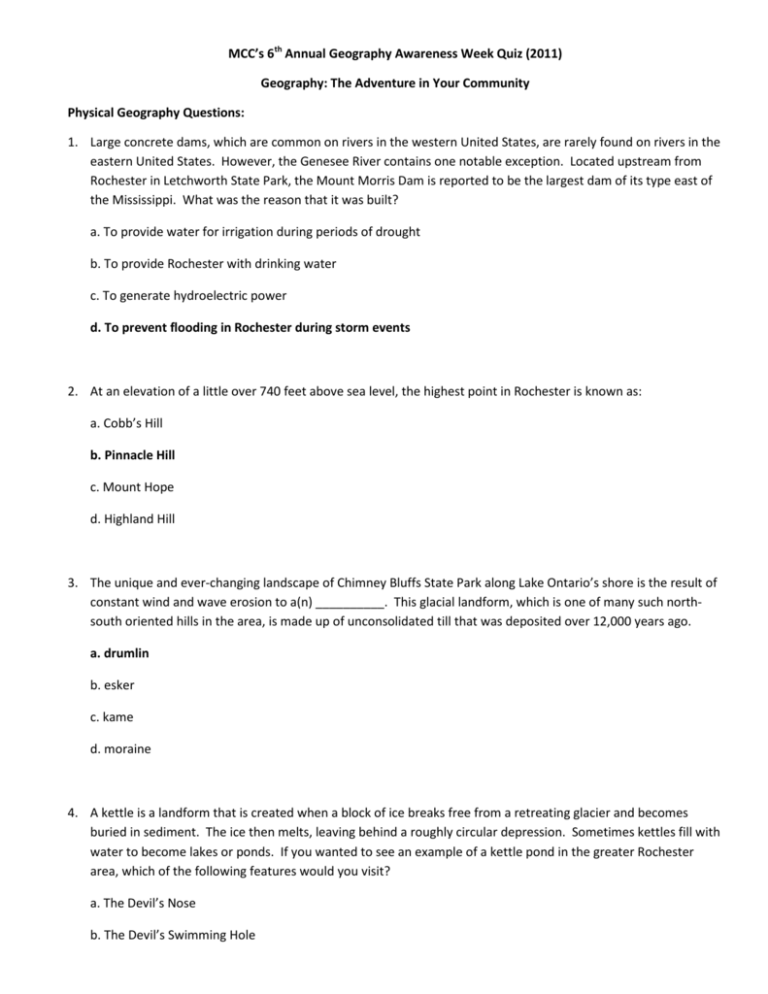
MCC’s 6th Annual Geography Awareness Week Quiz (2011) Geography: The Adventure in Your Community Physical Geography Questions: 1. Large concrete dams, which are common on rivers in the western United States, are rarely found on rivers in the eastern United States. However, the Genesee River contains one notable exception. Located upstream from Rochester in Letchworth State Park, the Mount Morris Dam is reported to be the largest dam of its type east of the Mississippi. What was the reason that it was built? a. To provide water for irrigation during periods of drought b. To provide Rochester with drinking water c. To generate hydroelectric power d. To prevent flooding in Rochester during storm events 2. At an elevation of a little over 740 feet above sea level, the highest point in Rochester is known as: a. Cobb’s Hill b. Pinnacle Hill c. Mount Hope d. Highland Hill 3. The unique and ever-changing landscape of Chimney Bluffs State Park along Lake Ontario’s shore is the result of constant wind and wave erosion to a(n) __________. This glacial landform, which is one of many such northsouth oriented hills in the area, is made up of unconsolidated till that was deposited over 12,000 years ago. a. drumlin b. esker c. kame d. moraine 4. A kettle is a landform that is created when a block of ice breaks free from a retreating glacier and becomes buried in sediment. The ice then melts, leaving behind a roughly circular depression. Sometimes kettles fill with water to become lakes or ponds. If you wanted to see an example of a kettle pond in the greater Rochester area, which of the following features would you visit? a. The Devil’s Nose b. The Devil’s Swimming Hole c. The Devil’s Bathtub d. The Devil’s Kitchen Sink 5. Although Buffalo is known for its heavy lake effect events, between 1981 and 2010, the Rochester International airport has averaged 99.5 inches of snow while the Buffalo International airport has averaged 95 inches. This difference is a result of their location and the length of the lake effect response over Lake Ontario as compared to Lake Erie. Since Lake Erie has a much smaller _________ compared to Lake Ontario, more of the surface of Lake _____ freezes over, resulting in a reduced lake effect response in late winter. a. surface area, Erie b. depth, Ontario c. surface area, Ontario d. volume, Erie 6. The growth of Rochester in the 1800’s was primarily a result of water power from the three cataracts of the Genesee River near present day Rochester, and the Erie Canal. In the 1800’s water from the falls were diverted into raceways that generated power for the flour mills. Today, water is diverted above which waterfall for hydroelectric power? a. Low Falls b. Middle Falls c. Ontario Falls d. High Falls 7. The great ice storm of March 1991 devastated the Rochester region with approximately $375 million dollars worth of damage. Many had no power for days, and some for two weeks. The Red Cross opened over 50 shelters in the area so people could stay warm and have fresh food. Ice storms are a result of ______ events which are caused by ______________: a. freezing rain; liquid water freezing upon impact with any object it encounters. b. sleet; ice crystals melting in a warm layer (above freezing) and then refreezing before reaching the surface. c. freezing rain; ice crystals melting in a warm layer (above freezing) and then refreezing before reaching the surface. d. sleet; liquid water freezing upon impact with any object it encounters. 8. Although western New York is not known for its earthquakes as compared to Japan and California, they have occurred in the past. In 2010, the Rochester region experienced some minor shaking on June 23rd from an earthquake centered north of Ottawa, Canada and even more recently from the August 23rd earthquake in Virginia. On August 12 of 1929, a 5.6 magnitude earthquake was centered near Attica, NY, resulting in over 250 damaged chimneys. This quake was a result of the ____________ fault, the chief source of earthquake activity in our region. a. San Andreas b. Clarendon–Linden c. Ramapo d. Genesee 9. Lake Ontario takes much longer to warm up in the spring compared to daytime temperatures over land because water has a ____ specific heat capacity. The cooler air over the lake creates a stable environment, inhibiting cloud growth. This phenomenon is known as ______________. a. high; lake effect precipitation b. high; the oasis effect c. high; orographic precipitation d. low; convective precipitation Human Geography Questions: 10. The U.S. Census Bureau would define Monroe County, NY and adjacent counties that have a high degree of social and economic integration (as measured by commuting to work) as: a. an urbanized area. b. an urban cluster. c. a micropolitan statistical area. d. a metropolitan statistical area. 11. The U.S. Census Bureau would define Rochester, NY plus its densely populated suburbs (e.g. Greece, Irondequoit, etc.) as: a. a central city. b. an urbanized area. c. an urban cluster. d. a micropolitan statistical area. 12. Geographers study the evolution of places over space and time. __________ is considered the first white settlement in what is now the city of Rochester, NY. Its population was nearly decimated by “Genesee fever” (i.e. malaria). a. Charlotte b. Hanford’s Landing c. King’s Landing d. Rochesterville 13. Rochester was nicknamed the “Flour City” in the early 19th century due to its unique position on the Genesee River. The falls created enough power to generate the mills used for the grinding of wheat into flour. By the mid19th century, the city was no longer a major flour producer, and was ringed by greenhouses and nurseries. Evidence for the change in nicknames from the “Flour City” to the “Flower City” can still be seen today with the many conservatories, gardens and festivals. One of these festivals, the Lilac Festival, is incredibly large and draws people from all over the world. Where is the main portion of this festival held? a. Ellison Park b. Maplewood Rose Garden c. Durand-Eastman Park d. Highland Park 14. The Erie Canal connects Lake Erie to the Hudson River and bypasses Lake Ontario and Niagara Falls. The Erie Canal helped Rochester become the first “boomtown” of the United States and ran right through the center of the city. An aqueduct fed the canal over the Genesee River before the canal was rerouted south of the city when rail became more convenient. The old aqueduct served as part of the subway system in Rochester, and then it was voted, in 2010 to fill a portion of it in, due to safety concerns. The ___________________ is the top portion of the old aqueduct/subway tunnel, and remains one of the last vestiges of the old canal system. The other remnant of the old canal system in Rochester, the _____________ can be seen in Fairport. a. Broad Street Bridge; Lift Bridge b. Ford St Bridge; Tow path c. Driving Park Bridge; Lock d. Hojack Swing Bridge; Canal 15. Rochester’s Historic South Wedge Neighborhood is an excellent example of this geographic model of urban structure. a. concentric zone model b. multiple nuclei model c. sector model d. Von Thunen's model 16. __________ is considered an ethnic enclave because of its large Jewish population. a. Brighton, NY b. Greece, NY c. Henrietta, NY d. Irondequoit, NY 17. Human Geographers define a community as a social group of any size whose members reside in a specific locality, share government, and often have a common cultural and historical heritage. Like many cities, Rochester has many different communities and many different neighborhoods. In the last few years, many of the neighborhoods in downtown have been struggling to reinvent and reclaim a sense of community. This process is called: a. Rejuvenation b. Urban Sprawl c. Revitalization d. Reunification 18. Rochester is home to many famous people; Rochester also has many famous homes. The George Eastman House, the Susan B. Anthony house, and many of the homes in the Corn Hill neighborhood are available for tours at least once a year. There is another locally famous house that only rarely is open – The Mushroom House. This house is in Powder Mills Park in Bushnell’s Basin and is not modeled on a Mushroom at all but rather (a): a. Rose b. Queen Anne’s Lace c. Dandelion d. Linden Tree Blossom Geographic Techniques Questions 19. Students taking GEG 130 (Digital Earth) at MCC discover that Geographical Information Systems (GIS) allows one to analyze just about anything! Student projects have ranged from analyzing wind farms in New York, finding the optimal location for a local business, murder rates in Rochester, and hydraulic fracturing. A recent GIS project utilized aerial images and GIS to create a map of a local cemetery. What is the name of the cemetery shown below? a. Holy Sepulchre Cemetery b. Mount Hope Cemetery c. Riverside Cemetery d. Britton Road Cemetery 20. GIS falls within a field called geospatial techniques, or the use of technology to analyze anything over space. Another geospatial technique is called remote sensing. Remote sensing uses images taken above earth to better understand the world. After the devastating earthquake in _____, the World Bank contracted with the Rochester Institute of Technology (RIT) Center for Imaging Science to collect high quality images to aid in the relief efforts. a. Haiti b. Indonesia c. Japan d. California Thank you for taking the 2011 Geography Awareness Week Quiz!


